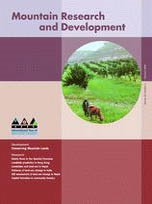On 28 November 2001, within the framework of the 4th International Symposium on Sustainable Development in the Andes (AMA-Mérida 2001), which took place in Mérida de los Andes, Venezuela, over 70 representatives of research institutions and governmental, nongovernmental, and rural organizations from all the Andean countries, as well as several North American and European countries, agreed to form an international network, the Grupo Páramo or Páramo Group. This network will devote itself to exchange of information and experience, expert discussions, and the elaboration of lines of action to promote the conservation and appropriate management of the Andean high-mountain humid grasslands or páramo.
The páramo is a natural humid high-mountain ecosystem in the northern Andes with a unique biodiversity. Its position as a biological corridor and as the source of the South American hydrological system makes it an extremely important ecosystem. Not least, the páramo is inhabited by an economically poor but culturally rich high-Andean native population. However, this fragile ecosystem is greatly endangered by intensified human impacts and vulnerability to climate change.
The need for multidisciplinarity and interinstitutionality
The members of the Páramo Group recognize the need for urgent, integrated responses at the global, regional, national, and local levels to the human and biophysical threats to the páramo ecosystem. The Group's vision is therefore to develop a platform that will make it possible to exchange experiences, identify priorities for action, and adjust agendas for the Andean region in order to avoid duplication and maximize resources. Integration of scientific, socioeconomic, and political initiatives that allow for comparative and collaborative efforts will take place at the international level. Five priority topics were identified:
Investigation and exchange of experience.
Conservation and protected areas.
Sustainable use and community participation.
Policy and environmental services.
Information management, awareness building, and environmental education.
The Group promotes a holistic approach, based on multidisciplinarity and interinstitutionality, to integrate lines of action.
Membership and activities
The Páramo Group, which is open to anyone who wishes to join, will include independent national groups working in collaboration with an international secretary. The Group's first activity will be the creation of a páramo database, including all of the actors and ongoing activities in each country. It will then identify, on a country-by-country basis, priority areas for action. International groups will complement the national groups by developing research on transversal issues. The first of these thematic groups has already been constituted to work on páramo research and exchange of information.
The interim coordinators are Maximina Monasterio (Venezuela, AMA-Mérida), Carlos Castaño Uribe (Colombia, IDEAM, Congreso Mun dial de Páramos), Doris Ortiz (Ecuador, Grupo de Trabajo en Páramos), Jorge Recharte (Peru, Grupo Nacional de Trabajo en Ecosistemas de Montaña, Grupo de Trabajo en Páramo Piura), Máximo Liberman (Bolivia, Instituto de Ecología), Alejandro Brown (Argentina, Universidad de Tucumán) and Adelaida Chaverri (Costa Rica, Universidad Nacional).
Members of the Páramo Group will rely on the Internet and personal encounters at meetings and congresses—for example during the World Páramo Congress in May 2002 in Colombia—to exchange experiences. The executive summary of the founding meeting of the Páramo Group, as well as the list of participants, can be found on the following web pages: www.paramo.org and www.condesan.org






